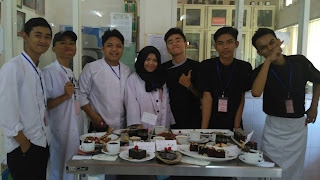Sate Lilit
Sumber :
https://en.m.wikipedia.org/wiki/Sate_Lilit
Sate Lilit is a satay variant from Balinese cuisine. This satay is made from minced pork, fish, chicken, beef, or even turtle meat, which is then mixed with grated coconut, thick coconut milk, lemon juice, shallots, and pepper. The spiced minced meat is wound around bamboo, sugar cane or lemongrass sticks, it is then grilled on charcoal. Unlike skewers of other satay recipes which is made narrow and sharp, the bamboo skewer of sate lilit is flat and wide. This wider surface allowed the minced meat to stick and settle. The term lilit in Balinese and Indonesian means "to wrap around", which corresponds to its making method to wrapping around instead of skewering the meat.
Coto Makassar
Sumber :
https://en.m.wikipedia.org/wiki/Coto_Makassar
Coto Makassar or Coto Mangkasara (Makassarese), is an Indonesian traditional soup originating from Makassar, South Sulawesi. It is a variant of soto traditional beef and offal stew with seasoned broth made from ground peanuts and spices. The main ingredient of this soup is beef and it can be mixed with innards such as intestine, liver, lungs, heart, tripe, or cow brain.

Thursday, 27 July 2017
Today we follow the accesment in the classroom that has been prepared in the education hall of makassar industry, after that we go to the next activity is to evaluate our teachers during the education hall of makassar industry.
Then the next day we do the practice per individual in the kitchen Tourism Polytechnic of makassar. I am with senior sister from makassar country university got lottery to make brownies, after brownies we made, we do general cleaning and go back to boarding house of makassar industry center.
After that on Saturday is our last day in makassar industry hall, the closing is done by the head of the hall of Makassar industrial training center. I feel so Happy because i can join in this training, I getting many science abaout Chocolate.
1. Gado-gado

Gado-gado is the one salad
from Indonesia that needs no introduction. The creamy, sweet, sour, and spicy
peanut sauce is really what makes this a great salad. If there is such a thing
as a national salad, this gado-gado will be it. Gado-gado is
one of Indonesia's most favourite dish everywhere in the world. It is actually
vegetable salad dressed in specially prepared peanut sauce. In Indonesia, there
are a few dish that resemble gado-gado (with the same kind, or a variation of
peanut sauce), such as pecel, lotek, and ketoprak. Pecel and lotek is the
closest to gado-gado, so people often mistake them as gado-gado. Preparation of
gado-gado is mainly the preparation of the peanut sauce. There are many
gado-gado recipes in the Internet, but most of them advice the use of peanut
butter or freshly fried peanut grinded with a blender. But the original
traditional Indonesian gado-gado uses cobek batu (Indonesian style stone
pestle). This is one of the ingenous Indonesian food preparation technique.
Ingredients :
Peanut Sauce :
- 200 gram peanut, deep fried or
roasted
- 4 cloves garlic
- 50 gram palm sugar (Indonesian:
gula Jawa)
- 1 to 10 Thai chilies (Indonesian:
cabe rawit), seeded - use as much or as little as you like
- 1 tablespoon salt
- 1 teaspoon toasted shrimp paste
(Indonesian: terasi), omit to make a vegetarian sauce
- 1 teaspoon tamarind pulp, soaked
in 2 tablespoon of warm water to get the juice
- juice of 1 lime
- 1 tablespoon sweet soy sauce
(Indonesian: kecap manis)
- 2 cup hot water
Must Have Salad Ingredients :
- 4 potatoes, peeled, cubed, and
boiled
- 4 eggs, hard boiled, peeled, and
cut into quarters
Optional Salad Ingredients :
- blanched cabbage (Indonesian:
kol)
- blanched bean sprouts
(Indonesian: tauge)
- blanched snake beans (Indonesian:
kacang panjang)
- blanched green beans (Indonesian:
buncis)
- blanched spinach (Indonesian:
bayam)
- raw cucumber (Indonesian: timun)
- boiled chayote (Indonesian: labu
siam)
- deep fried tofu
- deep fried tempeh
- melinjo crackers (Indonesian:
emping)
Instructions :
Peanut Sauce :
- Place peanut, garlic, palm sugar,
Thai chilies, salt, and toasted shrimp paste in a food processor. Grind until
everything is well mixed. Remove into a mixing bowl.
- Add tamarind juice, lime juice,
and sweet soy sauce and mix well.
- Pour only enough of the hot water
while keep stirring to get to the consistency of peanut sauce that you like.
To serve :
- Place some boiled eggs, boiled
potatoes, and whatever optional salad ingredients that you want to have in your
gado-gado. Serve the peanut sauce in a small bowl.
- Just prior to eating the salad,
pour the peanut sauce and mix well
Sumber :
http://recipes.wikia.com/wiki/Gado-gado
2. Gudeg
 Gudeg is a traditional Javanese cuisine
from Yogyakarta and Central Java, Indonesia. Gudeg is made from young unripe
jack fruit (Indonesian : nangka muda) boiled for several hours
with palm sugar, and coconut milk. Additional spices include garlic,
shallot, candlenut, coriander seed, galangal, bay leaves, and teak leaves, the
latter giving a reddish-brown color to the dish. It is often described as
"green jack fruit sweet stew".
Gudeg is a traditional Javanese cuisine
from Yogyakarta and Central Java, Indonesia. Gudeg is made from young unripe
jack fruit (Indonesian : nangka muda) boiled for several hours
with palm sugar, and coconut milk. Additional spices include garlic,
shallot, candlenut, coriander seed, galangal, bay leaves, and teak leaves, the
latter giving a reddish-brown color to the dish. It is often described as
"green jack fruit sweet stew".
Sumber :
https://en.m.wikipedia.org/wiki/Gudeg


























